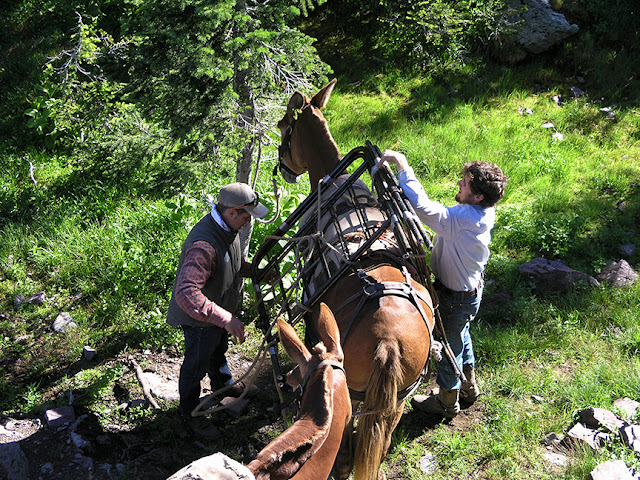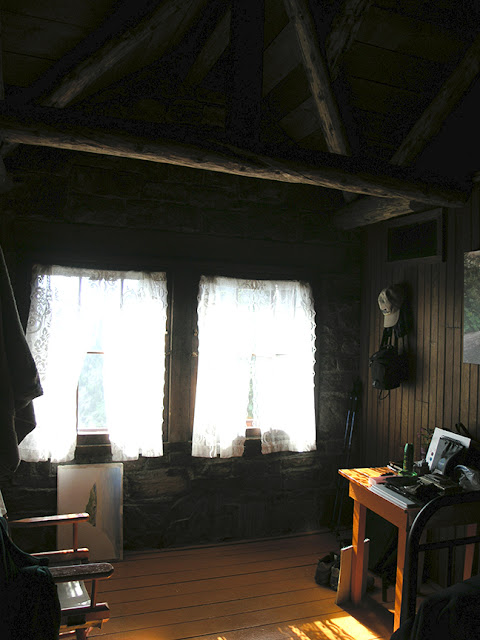 |
| Rachel soothes a skittish mule. |
It was Thursday, and the mule pack bringing up supplies arrived around ten, after I'd finished my morning sketch session. After putting my gear back in my room I was walking down the Chalet's deck when I saw Rachel talking softly, trying to soothe one of the mules tied to the railing. She explained that the mules didn't like being on the rocky ground around the Chalet, and needed extra coaxing.
Renee and the staff would pack the stuff that was going back down in large plastic trash cans the night before, so it would be ready to load onto the mules once the supplies had been unloaded. It was fascinating to watch how quickly and efficiently the staff unloaded and put away the fresh supplies while the packers re-loaded the mules with the stuff going back.
 |
| Renee unloads fresh supplies for the Chalet. |
Today, they were sending down some of the old bed frames no longer in use, in addition to the usual dirty laundry, trash, and empty gas cylinders. I'm sure it took a good deal of planning and sometimes last-minute juggling on Kevin's part to keep the stream of supplies flowing smoothly. I imagine the cost of the mule packs running for the entire season might be the single largest expense for the Chalet.
The packers brought the mules to the back of the chalet, where I took photos of them from one of the balconies on the second floor. They duct-taped the bed frames into a nicely balanced A-frame.
 |
| Packing the bed frames. |
 |
| A mule packer duct tapes the frames together |
 |
| Leading the mules down. |
After the frames had been secured, the men led the mules down to join the other mules tied by the dining room posts. For me, watching these young men work was like being in a western movie, except these guys weren't actors and their work was obviously hard. They seemed to enjoy it--a hard life, but probably a good one for these parts!
 |
| Pink Mountain Heather (Phyllodoce empetriformis) |
After the mule train departed, I took my art gear to the area in back of the
Chalet to sketch the pink mountain heather plants I'd seen there the day
before along the trail. I worked on a color pencil sketch of it, and included a sprig of the
subalpine firs that grew all over.
 |
| Pink Mountain Heather (Phyllodoce empetriformis) and Subalpine fir (Abies lassiocarpa), color pencil, 10" x 8" |
I wish my sketch could have done justice to the beauty of this small plant, but all I could do was to try to render its features faithfully: the needle-like narrow leaves on the twisted stems and the bunch of tiny pink bells at the ends. The leaves of the subalpine fir look very similar, although it is from a very different family of plants than the Mountain Heather. Both plants showed new shoots of yellow-green leaves against the darker green of previous years' growth. In the short growing season here every plant had to produce new growth very quickly at the beginning of July to have it mature by the beginning of September, when the first snows would arrive.
 |
| My room at Sperry Chalet |
 |
| My room. |
After a few days my single room on the second floor facing west, was beginning to feel like home. I had arranged all my art supplies on the small table, where I could sit to work when my eyes needed rest from the bright light outdoors. The photograph on the wall was the work of one of the previous resident artists, and it was lovely to look at--printed on canvas. Considering its size, I wondered if it had been difficult to bring up on the mules, and how it had been packed.
All personal effects were hung from hooks on the walls (there were no closets) because there was no way to keep small critters such as mice and voles out. I had staff privileges, which meant access to the one shower the staff shared (hot water was such a luxury here!) in a separate building, and I could hand-wash my clothes too. I' d been instructed to shower in the morning before breakfast or in late afternoon, while the rest of the staff was busy with other chores, so as not to get in their way. And I learned to hang my freshly washed clothes on the line so that nothing hung down within the reach of goats (they like to eat soap too--minerals!)
At night I hung my miner's lamp and a tiny LED battery-run lamp from my bed frame so I could read a little in bed before going to sleep. I usually have to get up in the middle of the night to use the bathroom, and the first night, walking in the pitch dark was very scary--I kept picturing grizzlies lurking in the shadows of my headlamp, just waiting to pounce.
But as time went on, I got over that and once I'd reached the deck of the Chalet, I'd turn off the headlamp to look up at the night sky. With no light pollution here, the Milky Way seemed so close and bright--it was a beautiful sight! It's amazing how much one's eyes can detect once the pupils adjust--I could make out the outlines of the mountain ranges, trees and rocks as I became familiar with them, and once in a while, catch sight of a mountain goat near the Chalet.









































